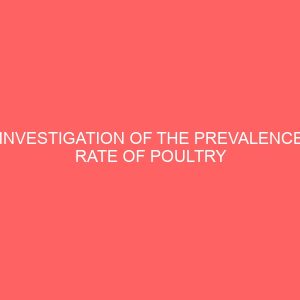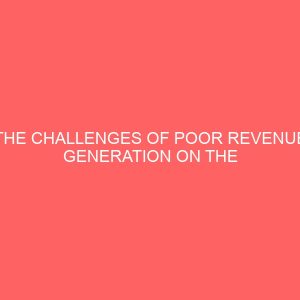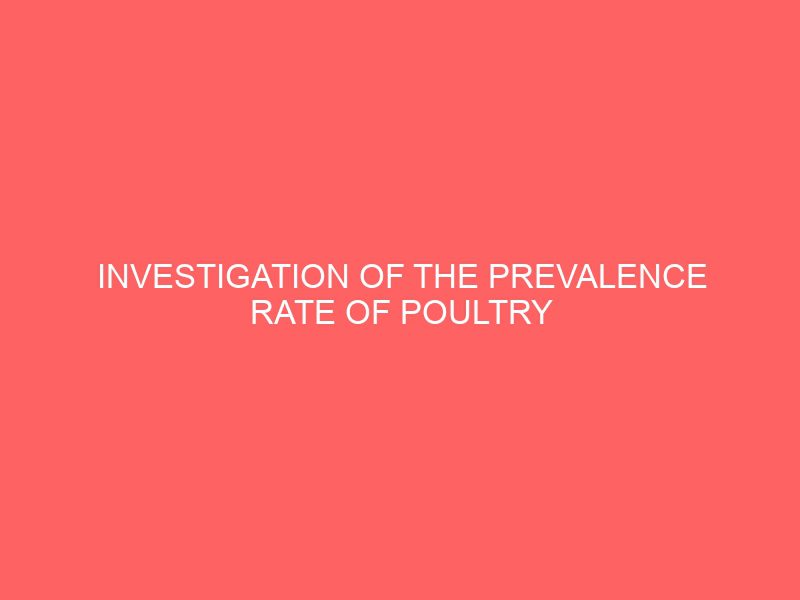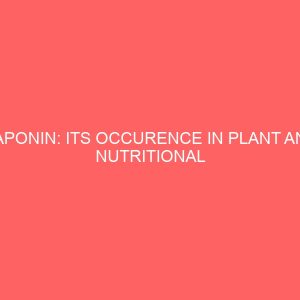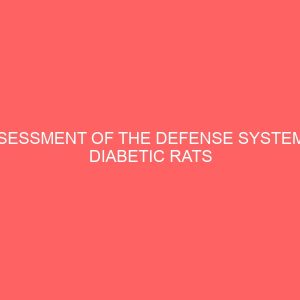Description
CHAPTER ONE
INTRODUCTION
BACKGROUND OF THE STUDY
Agriculture in Nigeria has remained the largest sector contributing nearly 39% to the gross domestic product for the past two decades and employing nearly 60% of its workforce. Over 80% of the country’s population in the rural areas is directly or indirectly dependent on agriculture for its livelihood (NBC,2005). The Nigeria livestock resources consist of 13,885,813 cattle; 34,453,724 Goat; 22,092, 602 sheep; 3,406,381 pigs; 104,247,960 poultry (Rim, 1992). From these figures, poultry is about 58. 72% of the total livestock production which indicates the place of poultry sub-sections in the livestock industry.
Poultry plays an important economic, nutritional and socio-cultural role in the livelihood or rural household in many developing countries including Nigeria. Poultry are birds that include fowl, turkey, duck, goose, ostrich guinea fowl, pigeon etc. which render not only economic services but contribute significantly to human food as a primary supplier of meat, egg, raw materials for industries (feathers, waste products), source of income and employment to people compare to other domestic animals (Avila 1985; Demehe, 2004).
Poultry meat and eggs play a very useful role in protein production in Nigeria. They are palatable and generally acceptable. This acceptability cuts across nearly all cultural region boundaries in Nigeria. Poultry industry plays important role in the development of Nigeria economy. Poultry production has become a full time job for many Nigerians and significantly contribute to the Groose National Product (GNP) (Umeh and Odo; 2002). Poultry products mainly meat and eggs represent important food for improving the nutritional status particularly of the most vulnerable populations-children and pregnant women. Poultry production is an important part of farming in many parts of the world. The major attracting factor in poultry production is probably the tendency of providing a fairly rapid return on capital (Abdulkali; 2002).
The poultry industry in Nigeria has recorded considerable expansion in recent time (FAO, 2000). For example, the creation of Akwa Ibom State in 1987 and the increased activities of oil and gas companies in the area with the resultant improvement in the demand for animal protein especially in the form of poultry products. This has led to the establishment of poultry farms which are located in Uyo agricultural zone of the state. While overall national increase in poultry production has probably triggered off vigorous research into alternative and cheaper feed resources urgently needed to sustain such growth: there is the need to continually focus attention on the health of the animals in other to realize the full potential of the industry (Fasami; 1990).
Poultry diseases remain one of the major threats to boosting poultry production in Nigeria (Halle et al., 1998; Laseinde, 2002). Poultry diseases continue to play major central role in hampering its development (FAO, 1998; Rushton et al, 1999) The impact of diseases on animal agriculture is typically assessed in quantitative terms. In poultry industry examples of these terms include lost revenues, costs of vaccination/prevention, eradication, decontamination and restocking. These have been referred to as a negative input (Unrusfield, 1995). In Nigeria, diseases are among the major factors that hinder poultry development (Alanargot, 1987; Alemu, 1995).
A lot of losses in poultry have been linked to diseases causing agents such as viruses, bacteria and parasites. It has been estimated that more than 750 million chicken, guinea fowls and duckling in Africa die each year as a result of various infections (Sonaiya 1990). Although somewhat in birds parasitic has been achieved by commercial production system mostly due to improved housing hygiene and management practices, the prevalence of infectious diseases is still very rampant (pandry et at: 1992). Nigeria has a comparatively well developed poultry industry for West African Nation.
Apantaku (2006) described this trend to the low level of poultry production in comparison to the level of poultry technologies being generated by Nigerian poultry researchers. The prevailing situation became worsen in 2006 by the reported outbreak of highly pathogenic and viral diseases like Avian influenza, Newcastle disease, infectious bursal disease and coccidiosis. Obayelu (2007) reports that the diseases outbreak led many poultry farmer into psychological breakdown due to losses incurred and also affected animal protein intake of a large sector of Nigeria population.
Major limitations confronting the industry are numerous. The problems confronting the poultry industry in Nigeria include disease, low egg production, poor chick quality, poor weight gain, lack of capital, management problems etc (Van et al.; 1995; Apan taku et al; 1998; Ojo; 2003). Other problems include high cost of drugs and equipment such as battery cases, high cost of feeding, increasing cost of medications, marketing and lack of storage facilities as well as unfriendly government policy and finance. Sources of economic losses in poultry include lack of technical know-how, poor quality feed, poor housing, mismanagement and of great significance, disease outbreak which had received tremendous attention (Adekumisi et al; 1996; Torimiiro et. al., 2002).
Despite the economic significance of the diseases to the commercial and small scale poultry producers in the country, no substantial research has been done to asses its economic losses. With the increasing interest in poultry production evidenced by the proliferation in poultry farms, it is pertinent to continually evaluate the prevalence rate and management issues associated with common poultry disease such as Avian influenza, Newcastle disease, infectious bursal disease and coccidiosis.
STATEMENT OF THE PROBLEM
The incidence of poultry diseases in Nigeria has led many poultry farmers into psychological breakdown due to losses incurred. Poultry diseases has a gross attack rate on commercial poultry production. Culling birds in order to eradicate and control the spread of the diseases has negatively affected the livelihoods of all classes of poultry owners and producers. Such an impact is most serious on the smaller family producer and commercial producer whom poultry production is their sole of income generation. Effects of poultry diseases on the economy. Where market is lost through the reduced rate to export, restriction of movement of birds and the closing of some domestic markets is especially the constraint which affect the income generating ability of smaller producers in the zone (Mettzer et al., 1999). The non consumption of poultry meat as well as its products has also affected animal protein intake in the large sector of the population. The most pronounced affect is the sharp decline in demand as people avoided eating and demanding for poultry product out of fear of being infected (WHO, 2004a). The survivability of poultry industry in Nigeria is very low due to poor management techniques embarked upon by rural poultry farmers, and outbreak of seasonally defendant diseases that can account for high chick losses and mortality.
Purpose of the Study
The study is aimed at examining the prevalence rate of poultry diseases and mortality of flock in the study area. Specifically the study seeks the following objectives.
To determine the prevalence rate of Avian influence and its mortality rate on poultry in Uyo Local Government Area.
To determine the prevalence rate of Newcastle Disease and it mortality rate on poultry in Uyo Local Government Area.
To determine the prevalence rate of infectious Bursal disease and its mortality rate on poultry in Uyo Local Government Area.
To determine the prevalence rate of coccidiosis and its mortality.

